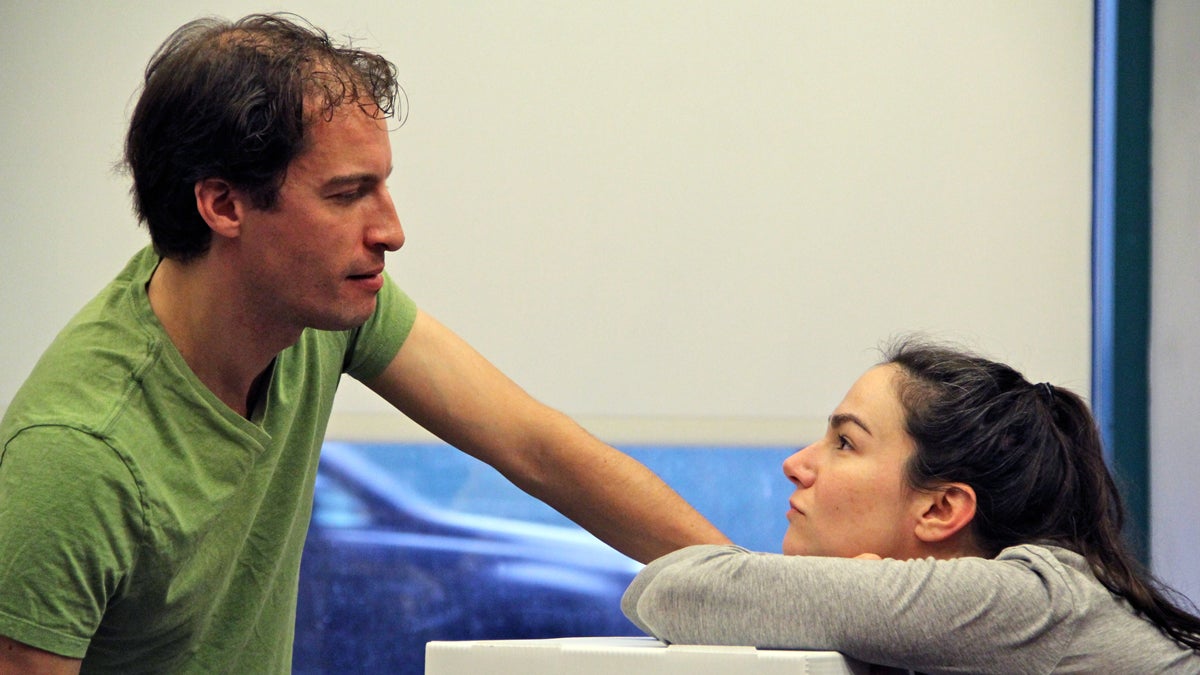‘The Hard Problem’: seeking science of consciousness
Listen
Sarah Gliko and Ross Beschler rehearse their roles as Hillary and Spike in a Wilma Theater production of Tom Stoppard's The Hard Problem
There are easy problems, and there are hard problems. Let’s get the easy one out of the way first.
Understanding how the brain reacts to certain stimuli is relatively easy. If you stub your toe, neuroscientists know how your nerves send signals to a certain portion of your brain, which lights up. That’s pain. And while pain sucks, we get it.
The hard problem is consciousness: how people are aware of themselves such that they develop personalities, thoughts, and feelings. The traditional scientific method can’t account for subjectivity.
“We understand things as mechanisms. The brain is a giant mechanism. That’s great for explaining things like behavior and response. It works for things like biology and chemistry,” said David Chalmers, a professor of philosophy at New York University.
“With consciousness, we have this added element of subjectivity at the very core; what it feels like inside. It’s a whole new thing, so we need a whole new kind of explanation,” said Chalmers.
In the 1990s, Chalmers coined the phrase “the hard problem” to focus attention on the thorny issue as a scientific conundrum, not an abstract philosophical one. Around that time, neurobiologists and biologists began applying scientific methods to the study of consciousness. In 1995, the man who discovered the structure of DNA, molecular biologist Francis Crick, published “The Astonishing Hypothosis: the Scientific Search for the Soul.”
Stubbing your toe, as it turns out, is a pretty good barometer of consciousness. If you have ever described to a doctor your level of pain on a scale of one to 10 – known as the pain scale – you essentially revealed your state of consciousness.
“Pain is a part of consciousness,” said Chalmers. “Consciousness for me is anything that feels a certain way inside. Pain is a subjective experience. A paradigm one. So is vision, seeing a red triangle or a blue sky.”
There is no measurement to determine if the way you experience the color red is the same as the way I see it. This problem of consciousness has been with philosophy since the toga. Over time, as a way to talk about it, philosophers had to invent anti-consciousness, a hypothetical being that has no sense of self. A zombie.
Although a zombie appears to act like a normal person, it has no internalized concept of itself. It can’t ascribe meaning or value to anything it experiences.
Chalmers wrote a song about the zombie thought experiment, which he performs only at philosophy conference after parties.
“It would take a number of drinks for me to actually sing it,” said Chalmers.
I act like you actI do what you doBut I don’t knowWhat it’s like to be you.What consciousness is, I haven’t a clue.I’ve got the zombie blues.
There is another, more sober way to talk about consciousness. The newest play by Tom Stoppard is “The Hard Problem,” which debuted in London in the spring of 2015 and is now getting its U.S. premiere at the Wilma Theater in Philadelphia.
Stoppard, who is perhaps most well known for the 1966 play turned into the 1990 film, “Rosencrantz and Guildenstern are Dead,” first read about Chalmer’s challenge in the 1990s. He has been chewing the idea for two decades.
“It’s a relief to come across something you want to investigate further to write a play off it,” said Stoppard. “It’s a hard problem because nobody can explain or understand the fact of consciousness.”
Stoppard set out to explore the nature of morality and ethics, two very specific aspects of consciousness. “I think the idea of morality – the idea of a difference between good and bad – is unintelligible without consciousness,” said Stoppard.
The play involves a young woman, Hilary, applying for a coveted job at an academic institute studying the brain. Her advisor and sometimes lover, Spike, tries to convince her that all of human behavior is based on evolutionary biology. Even altruism is just survival-of-the-fittest in disguise.
“Culture, empathy, faith, charity – all the flip sides of egoism – come back to biology,” says Spike. “Because there ain’t anywhere else to come from, except three pounds of grey matter wired up in your head like a map of the London underground, with 86 billion stations, 30 trillion ways, hard-wired for ‘me first.'”
Hilary insists morality is innately valuable to humans, regardless of the survival instinct. But she can’t prove it.
“Human life is pointless without a sense of value in things which can’t be quantified,” said Stoppard. “I’m talking about thingst that have a sublime or metaphysical value that seems to be central to any kind of society – actually central to any human individual.”
Stoppard did not set out to write a philosophic treatise; he’s in the business of writing plays that are entertaining. Nevertheless, he is in the long philosophical tradition of writing fictional dialogues to work out thorny problems from multiple perspectives.
In that time-honored tradition, it’s a short step from a philosophical dialogue to an argument.
“I’m inclined to think there’s the problem of consciousness, and there’s the problem of morality. They are somewhat distinct problems, although they may have links,” said Chalmers. “Tom is much more inclined to think this all somehow comes together in a bundle, like maybe it’s the problem of the subjective human condition in the cold, objective world.”
WHYY is your source for fact-based, in-depth journalism and information. As a nonprofit organization, we rely on financial support from readers like you. Please give today.




